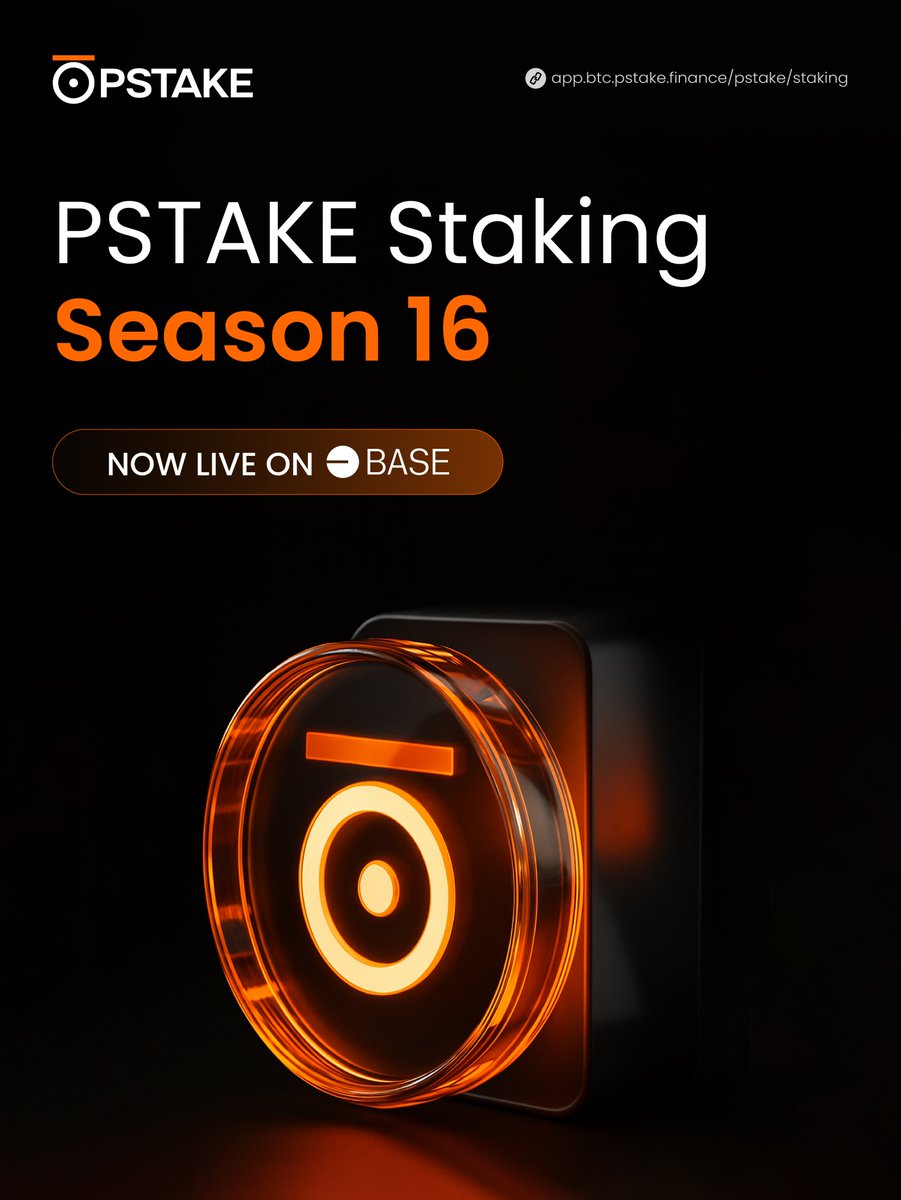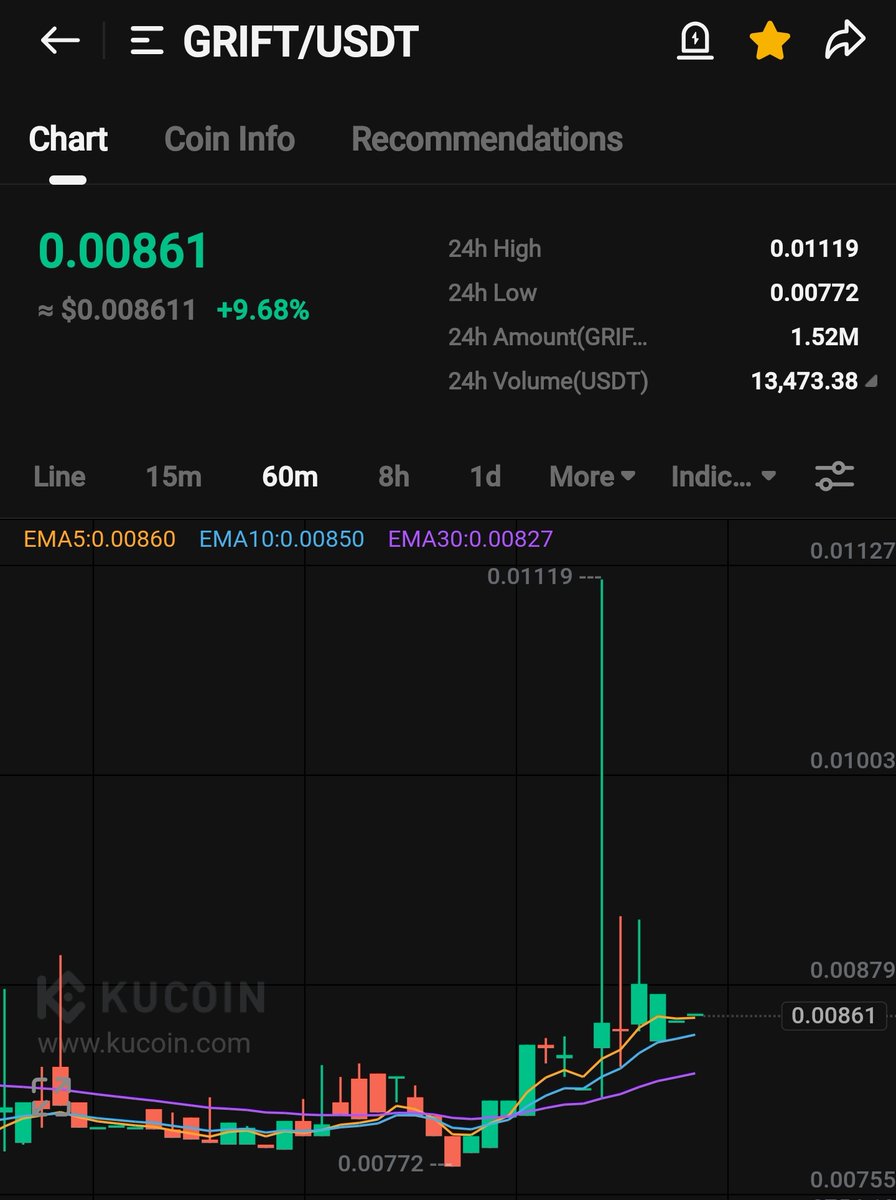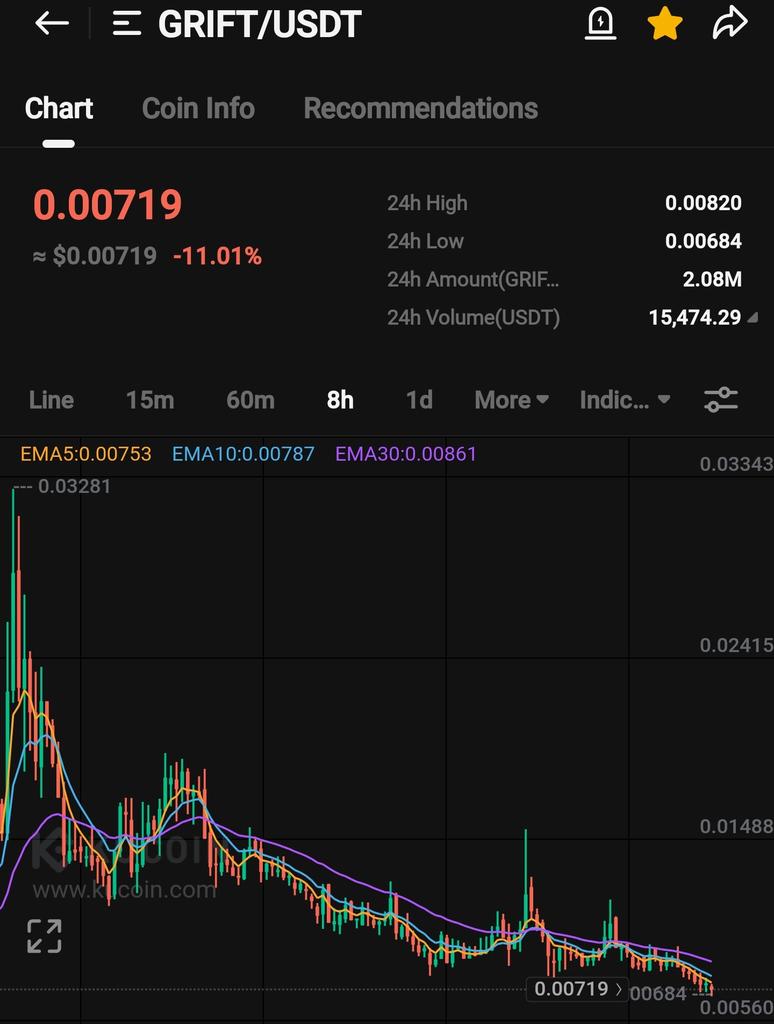
PSTAKE
pSTAKE Finance-pris
$0,034000
-$0,00024
(−0,71 %)
Prisendring fra 00:00 UTC til nå

Ansvarsfraskrivelse
Det sosiale innholdet på denne siden («Innhold»), inkludert, men ikke begrenset til, tweets og statistikk levert av LunarCrush, er hentet fra tredjeparter og levert «som det er» kun for informasjonsformål. OKX garanterer ikke kvaliteten eller nøyaktigheten til innholdet, og innholdet representerer ikke synspunktene til OKX. Det er ikke ment å gi (i) investeringsråd eller anbefalinger, (ii) et tilbud eller oppfordring til å kjøpe, selge eller holde digitale ressurser, eller (iii) finansiell, regnskapsmessig, juridisk eller skattemessig rådgivning. Digitale ressurser, inkludert stablecoins og NFT-er, innebærer en høy grad av risiko, og kan variere mye. Prisen og ytelsen til den digitale ressursen er ikke garantert og kan endres uten varsel.
OKX gir ikke anbefalinger om investering eller aktiva. Du bør vurdere nøye om trading eller holding av digitale aktiva er egnet for deg i lys av din økonomiske situasjon. Rådfør deg med din juridiske / skatte- / investeringsprofesjonelle for spørsmål om dine spesifikke omstendigheter. For ytterligere detaljer, se våre vilkår for bruk og risikoadvarsel. Ved å bruke tredjepartsnettstedet («TPN») godtar du at all bruk av TPN vil være underlagt og styrt av vilkårene på TPN. Med mindre det er uttrykkelig angitt skriftlig, er OKX og dets partnere («OKX») ikke på noen måte knyttet til eieren eller operatøren av TPN. Du godtar at OKX ikke er ansvarlige for tap, skade eller andre konsekvenser som oppstår fra din bruk av TPN. Vær oppmerksom på at bruk av TNS kan føre til tap eller reduksjon av eiendelene dine. Produktet er kanskje ikke tilgjengelig i alle jurisdiksjoner.
OKX gir ikke anbefalinger om investering eller aktiva. Du bør vurdere nøye om trading eller holding av digitale aktiva er egnet for deg i lys av din økonomiske situasjon. Rådfør deg med din juridiske / skatte- / investeringsprofesjonelle for spørsmål om dine spesifikke omstendigheter. For ytterligere detaljer, se våre vilkår for bruk og risikoadvarsel. Ved å bruke tredjepartsnettstedet («TPN») godtar du at all bruk av TPN vil være underlagt og styrt av vilkårene på TPN. Med mindre det er uttrykkelig angitt skriftlig, er OKX og dets partnere («OKX») ikke på noen måte knyttet til eieren eller operatøren av TPN. Du godtar at OKX ikke er ansvarlige for tap, skade eller andre konsekvenser som oppstår fra din bruk av TPN. Vær oppmerksom på at bruk av TNS kan føre til tap eller reduksjon av eiendelene dine. Produktet er kanskje ikke tilgjengelig i alle jurisdiksjoner.
pSTAKE Finance markedsinformasjon
Markedsverdi
Markedsverdien beregnes ved å multiplisere det sirkulerende tilbudet av en mynt med den siste prisen.
Markedsverdi = Sirkulerende tilbud × Siste pris
Markedsverdi = Sirkulerende tilbud × Siste pris
Sirkulerende forsyning
Totalbeløpet for en mynt som er offentlig tilgjengelig på markedet.
Markedsverdirangering
En mynts rangering i form av markedsverdi.
Historisk toppnivå
Høyeste pris en mynt har nådd i sin handelshistorikk.
Historisk bunnivå
Laveste pris en mynt har nådd i sin handelshistorikk.
Markedsverdi
$16,99 mill.
Sirkulerende forsyning
500 000 000 PSTAKE
100,00 % av
500 000 000 PSTAKE
Markedsverdirangering
279
Revisjoner

Siste revisjon: 26. juni 2021, (UTC+8)
Høyeste pris siste 24 timer
$0,034910
Laveste pris siste 24 timer
$0,033530
Historisk toppnivå
$1,4500
−97,66 % (-$1,4160)
Sist oppdatert: 24. feb. 2022, (UTC+8)
Historisk bunnivå
$0,0085900
+295,80 % (+$0,025410)
Sist oppdatert: 7. apr. 2025, (UTC+8)
Hva føler du om PSTAKE i dag?
Del følelsene dine her ved å gi en tommel opp hvis du føler deg optimistisk om mynten eller en tommel ned hvis du føler deg nedadgående.
Stem for å vise resultater
pSTAKE Finance-feed
Følgende innhold er hentet fra .

pSTAKE Finance | BTCFi 🧡
1/ $PSTAKE Staking sesong 16 er live på @base.
Sats PSTAKE og delta i protokollfellesskapsaktiviteter for å få $cbBTC belønninger.
S16 har et maksimalt tak på 12,5 millioner tokens, med 6,2 millioner+ tokens som allerede er satset.
🗓️ 27 juni - 11 juli 2025

9,45k
34
Konverter USD til PSTAKE


pSTAKE Finance prisutvikling i USD
Gjeldende pris på pSTAKE Finance er $0,034000. Siden 00:00 UTC, pSTAKE Finance har redusert ved −0,70 %. Den har for tiden en sirkulerende forsyning på 500 000 000 PSTAKE og en maksimal forsyning på 500 000 000 PSTAKE, noe som gir den en fullt utvannet markedsverdi på $16,99 mill.. For tiden har pSTAKE Finance-mynten 279. plass i markedsverdirangeringen. pSTAKE Finance/USD-prisen oppdateres i sanntid.
I dag
-$0,00024
−0,71 %
7 dager
-$0,00374
−9,91 %
30 dager
-$0,03524
−50,90 %
3 måneder
+$0,021770
+178,00 %
Populære pSTAKE Finance konverteringer
Sist oppdatert: 04.07.2025, 06:56
Om pSTAKE Finance (PSTAKE)
Den oppgitte vurderingen er en samlet vurdering som OKX har samlet inn fra de oppgitte kildene, og er kun ment som informasjon. OKX garanterer ikke for kvaliteten eller nøyaktigheten av vurderingene. Denne aktiviteten er ikke ment å gi (i) investeringsråd eller en anbefaling, (ii) et tilbud eller oppfordring om å kjøpe, selge eller holde digitale ressurser, eller (iii) finansiell, regnskapsmessig, juridisk eller skattemessig rådgivning. Digitale ressurser, inkludert stablecoins og NFT-er, innebærer en høy grad av risiko, og verdien kan variere mye, og til og med verdiløs. Prisen og ytelsen til digitale ressurser er ikke garantert og kan endres uten varsel. De digital ressursene dine er ikke dekket av forsikring mot potensielle tap. Historisk avkastning er ikke en indikasjon på fremtidig avkastning. OKX garanterer ikke avkastning, tilbakebetaling av hovedstol eller renter. OKX gir ikke anbefalinger om investeringer eller aktiva. Du bør nøye overveie om trading eller holding digitale ressurser passer for deg i lys av din økonomiske situasjon. Rådfør deg med din advokat/skatte- eller investeringsekspert hvis du har spørsmål om dine spesifikke forhold.
Vis mer
- Offisiell nettside
- Github
- Blokkutforsker
Om tredjepartsnettsteder
Om tredjepartsnettsteder
Ved å bruke tredjepartsnettstedet ("TPW") godtar du at all bruk av TPW vil være underlagt og styrt av vilkårene i TPW. Med mindre det er uttrykkelig angitt skriftlig, er OKX og dets tilknyttede selskaper ("OKX") ikke på noen måte knyttet til eieren eller operatøren av TPW. Du godtar at OKX ikke er ansvarlig eller ansvarlig for tap, skade eller andre konsekvenser som oppstår fra din bruk av TPW. Vær oppmerksom på at bruk av en TPW kan føre til tap eller reduksjon av dine aktiva.
pSTAKE Finance Vanlige spørsmål
Hvor mye er 1 pSTAKE Finance verdt i dag?
For øyeblikket er en pSTAKE Finance verdt $0,034000. For svar og innsikt i prishandlingen til pSTAKE Finance, er du på rett sted. Utforsk de nyeste pSTAKE Finance diagrammene og trade ansvarlig med OKX.
Hva er kryptovaluta?
Kryptovalutaer, for eksempel pSTAKE Finance, er digitale eiendeler som opererer på en offentlig hovedbok kalt blokk-kjeder. Lær mer om mynter og tokens som tilbys på OKX og deres forskjellige attributter, som inkluderer live-priser og sanntidsdiagrammer.
Når ble kryptovaluta oppfunnet?
Takket være finanskrisen i 2008 økte interessen for desentralisert finans. Bitcoin tilbød en ny løsning ved å være en sikker digital ressurs på et desentralisert nettverk. Siden den gang har mange andre tokens som pSTAKE Finance blitt opprettet også.
Vil prisen på pSTAKE Finance gå opp i dag?
Ta en titt på vår pSTAKE Finance prisantydningsside for å forutsi fremtidige priser og bestemme prismålene dine.
ESG-erklæring
ESG-forskrifter (Environmental, Social, and Governance) for kryptoaktiva tar sikte på å adressere deres miljøpåvirkning (f.eks. energikrevende gruvedrift), fremme åpenhet og sikre etisk styringspraksis for å tilpasse kryptoindustrien med bredere bærekraft- og samfunnsmål. Disse forskriftene oppfordrer til overholdelse av standarder som reduserer risiko og fremmer tillit til digitale eiendeler.
Aktivadetaljer
Navn
OKCoin Europe Ltd
Relevant juridisk enhetsidentifikator
54930069NLWEIGLHXU42
Navn på kryptoaktiva
pstake_finance
Konsensusmekanisme
pstake_finance is present on the following networks: Base, Binance Smart Chain, Ethereum, Optimism, Osmosis, Sui.
Base is a Layer-2 (L2) solution on Ethereum that was introduced by Coinbase and developed using Optimism's OP Stack. L2 transactions do not have their own consensus mechanism and are only validated by the execution clients. The so-called sequencer regularly bundles stacks of L2 transactions and publishes them on the L1 network, i.e. Ethereum. Ethereum's consensus mechanism (Proof-of-stake) thus indirectly secures all L2 transactions as soon as they are written to L1.
Binance Smart Chain (BSC) uses a hybrid consensus mechanism called Proof of Staked Authority (PoSA), which combines elements of Delegated Proof of Stake (DPoS) and Proof of Authority (PoA). This method ensures fast block times and low fees while maintaining a level of decentralization and security. Core Components 1. Validators (so-called “Cabinet Members”): Validators on BSC are responsible for producing new blocks, validating transactions, and maintaining the network’s security. To become a validator, an entity must stake a significant amount of BNB (Binance Coin). Validators are selected through staking and voting by token holders. There are 21 active validators at any given time, rotating to ensure decentralization and security. 2. Delegators: Token holders who do not wish to run validator nodes can delegate their BNB tokens to validators. This delegation helps validators increase their stake and improves their chances of being selected to produce blocks. Delegators earn a share of the rewards that validators receive, incentivizing broad participation in network security. 3. Candidates: Candidates are nodes that have staked the required amount of BNB and are in the pool waiting to become validators. They are essentially potential validators who are not currently active but can be elected to the validator set through community voting. Candidates play a crucial role in ensuring there is always a sufficient pool of nodes ready to take on validation tasks, thus maintaining network resilience and decentralization. Consensus Process 4. Validator Selection: Validators are chosen based on the amount of BNB staked and votes received from delegators. The more BNB staked and votes received, the higher the chance of being selected to validate transactions and produce new blocks. The selection process involves both the current validators and the pool of candidates, ensuring a dynamic and secure rotation of nodes. 5. Block Production: The selected validators take turns producing blocks in a PoA-like manner, ensuring that blocks are generated quickly and efficiently. Validators validate transactions, add them to new blocks, and broadcast these blocks to the network. 6. Transaction Finality: BSC achieves fast block times of around 3 seconds and quick transaction finality. This is achieved through the efficient PoSA mechanism that allows validators to rapidly reach consensus. Security and Economic Incentives 7. Staking: Validators are required to stake a substantial amount of BNB, which acts as collateral to ensure their honest behavior. This staked amount can be slashed if validators act maliciously. Staking incentivizes validators to act in the network's best interest to avoid losing their staked BNB. 8. Delegation and Rewards: Delegators earn rewards proportional to their stake in validators. This incentivizes them to choose reliable validators and participate in the network’s security. Validators and delegators share transaction fees as rewards, which provides continuous economic incentives to maintain network security and performance. 9. Transaction Fees: BSC employs low transaction fees, paid in BNB, making it cost-effective for users. These fees are collected by validators as part of their rewards, further incentivizing them to validate transactions accurately and efficiently.
The crypto-asset's Proof-of-Stake (PoS) consensus mechanism, introduced with The Merge in 2022, replaces mining with validator staking. Validators must stake at least 32 ETH every block a validator is randomly chosen to propose the next block. Once proposed the other validators verify the blocks integrity. The network operates on a slot and epoch system, where a new block is proposed every 12 seconds, and finalization occurs after two epochs (~12.8 minutes) using Casper-FFG. The Beacon Chain coordinates validators, while the fork-choice rule (LMD-GHOST) ensures the chain follows the heaviest accumulated validator votes. Validators earn rewards for proposing and verifying blocks, but face slashing for malicious behavior or inactivity. PoS aims to improve energy efficiency, security, and scalability, with future upgrades like Proto-Danksharding enhancing transaction efficiency.
Optimism is a Layer 2 scaling solution for Ethereum that uses Optimistic Rollups to increase transaction throughput and reduce costs while inheriting the security of the Ethereum main chain. Core Components 1. Optimistic Rollups: Rollup Blocks: Transactions are batched into rollup blocks and processed off-chain. State Commitments: The state of these transactions is periodically committed to the Ethereum main chain. 2. Sequencers: Transaction Ordering: Sequencers are responsible for ordering transactions and creating batches. State Updates: Sequencers update the state of the rollup and submit these updates to the Ethereum main chain. Block Production: They construct and execute Layer 2 blocks, which are then posted to Ethereum. 3. Fraud Proofs: Assumption of Validity: Transactions are assumed to be valid by default. Challenge Period: A specific time window during which anyone can challenge a transaction by submitting a fraud proof. Dispute Resolution: If a transaction is challenged, an interactive verification game is played to determine its validity. If fraud is detected, the invalid state is rolled back, and the dishonest participant is penalized. Consensus Process 1. Transaction Submission: Users submit transactions to the sequencer, which orders them into batches. 2. Batch Processing: The sequencer processes these transactions off-chain, updating the Layer 2 state. 3. State Commitment: The updated state and the batch of transactions are periodically committed to the Ethereum main chain. This is done by posting the state root (a cryptographic hash representing the state) and transaction data as calldata on Ethereum. 4. Fraud Proofs and Challenges: Once a batch is posted, there is a challenge period during which anyone can submit a fraud proof if they believe a transaction is invalid. Interactive Verification: The dispute is resolved through an interactive verification game, which involves breaking down the transaction into smaller steps to identify the exact point of fraud. Rollbacks and Penalties: If fraud is proven, the batch is rolled back, and the dishonest actor loses their staked collateral as a penalty. 5. Finality: After the challenge period, if no fraud proof is submitted, the batch is considered final. This means the transactions are accepted as valid, and the state updates are permanent.
Osmosis operates on a Proof of Stake (PoS) consensus mechanism, leveraging the Cosmos SDK and Tendermint Core to provide secure, decentralized, and scalable transaction processing. Core Components: Proof of Stake (PoS): Validators are chosen based on the amount of OSMO tokens they stake or are delegated by other token holders. Validators are responsible for validating transactions, producing blocks, and maintaining network security. Cosmos SDK and Tendermint Core: Osmosis uses Tendermint Core for Byzantine Fault Tolerant (BFT) consensus, ensuring fast finality and resistance to attacks as long as less than one-third of validators are malicious. Decentralized Governance: OSMO token holders can participate in governance by voting on protocol upgrades and network parameters, fostering a community-driven approach to network development.
The Sui blockchain utilizes a Byzantine Fault Tolerant (BFT) consensus mechanism optimized for high throughput and low latency. Core Components 1. Mysten Consensus Protocol: The Sui consensus is based on Mysten Labs' Byzantine Fault Tolerance (BFT) protocol, which builds on principles of Practical Byzantine Fault Tolerance (pBFT) but introduces key optimizations for performance. Leaderless Design: Unlike traditional BFT models, Sui does not rely on a single leader to propose blocks. Validators can propose blocks simultaneously, increasing efficiency and reducing the risks associated with leader failure or attacks. Parallel Processing: Transactions can be processed in parallel, maximizing network throughput by utilizing multiple cores and threads. This allows for faster confirmation of transactions and high scalability. 2. Transaction Validation: Validators are responsible for receiving transaction requests from clients and processing them. Each transaction includes digital signatures and must meet the network’s rules to be considered valid. Validators can propose transactions simultaneously, unlike many other networks that require a sequential, leader-driven process. 3. Optimistic Execution: Optimistic Consensus: Sui allows validators to process certain non-contentious, independent transactions without waiting for full consensus. This is known as optimistic execution and helps reduce transaction latency for many use cases, allowing for fast finality in most cases. 4. Finality and Latency: The system only requires three rounds of communication between validators to finalize a transaction. This results in low-latency consensus and rapid transaction confirmation times, achieving scalability while maintaining security. Fault Tolerance: The system can tolerate up to one-third of validators being faulty or malicious without compromising the integrity of the consensus process.
Insentivmekanismer og gjeldende gebyrer
pstake_finance is present on the following networks: Base, Binance Smart Chain, Ethereum, Optimism, Osmosis, Sui.
Base is a Layer-2 (L2) solution on Ethereum that uses optimistic rollups provided by the OP Stack on which it was developed. Transaction on base are bundled by a, so called, sequencer and the result is regularly submitted as an Layer-1 (L1) transactions. This way many L2 transactions get combined into a single L1 transaction. This lowers the average transaction cost per transaction, because many L2 transactions together fund the transaction cost for the single L1 transaction. This creates incentives to use base rather than the L1, i.e. Ethereum, itself. To get crypto-assets in and out of base, a special smart contract on Ethereum is used. Since there is no consensus mechanism on L2 an additional mechanism ensures that only existing funds can be withdrawn from L2. When a user wants to withdraw funds, that user needs to submit a withdrawal request on L1. If this request remains unchallenged for a period of time the funds can be withdrawn. During this time period any other user can submit a fault proof, which will start a dispute resolution process. This process is designed with economic incentives for correct behaviour.
Binance Smart Chain (BSC) uses the Proof of Staked Authority (PoSA) consensus mechanism to ensure network security and incentivize participation from validators and delegators. Incentive Mechanisms 1. Validators: Staking Rewards: Validators must stake a significant amount of BNB to participate in the consensus process. They earn rewards in the form of transaction fees and block rewards. Selection Process: Validators are selected based on the amount of BNB staked and the votes received from delegators. The more BNB staked and votes received, the higher the chances of being selected to validate transactions and produce new blocks. 2. Delegators: Delegated Staking: Token holders can delegate their BNB to validators. This delegation increases the validator's total stake and improves their chances of being selected to produce blocks. Shared Rewards: Delegators earn a portion of the rewards that validators receive. This incentivizes token holders to participate in the network’s security and decentralization by choosing reliable validators. 3. Candidates: Pool of Potential Validators: Candidates are nodes that have staked the required amount of BNB and are waiting to become active validators. They ensure that there is always a sufficient pool of nodes ready to take on validation tasks, maintaining network resilience. 4. Economic Security: Slashing: Validators can be penalized for malicious behavior or failure to perform their duties. Penalties include slashing a portion of their staked tokens, ensuring that validators act in the best interest of the network. Opportunity Cost: Staking requires validators and delegators to lock up their BNB tokens, providing an economic incentive to act honestly to avoid losing their staked assets. Fees on the Binance Smart Chain 5. Transaction Fees: Low Fees: BSC is known for its low transaction fees compared to other blockchain networks. These fees are paid in BNB and are essential for maintaining network operations and compensating validators. Dynamic Fee Structure: Transaction fees can vary based on network congestion and the complexity of the transactions. However, BSC ensures that fees remain significantly lower than those on the Ethereum mainnet. 6. Block Rewards: Incentivizing Validators: Validators earn block rewards in addition to transaction fees. These rewards are distributed to validators for their role in maintaining the network and processing transactions. 7. Cross-Chain Fees: Interoperability Costs: BSC supports cross-chain compatibility, allowing assets to be transferred between Binance Chain and Binance Smart Chain. These cross-chain operations incur minimal fees, facilitating seamless asset transfers and improving user experience. 8. Smart Contract Fees: Deployment and Execution Costs: Deploying and interacting with smart contracts on BSC involves paying fees based on the computational resources required. These fees are also paid in BNB and are designed to be cost-effective, encouraging developers to build on the BSC platform.
The crypto-asset's PoS system secures transactions through validator incentives and economic penalties. Validators stake at least 32 ETH and earn rewards for proposing blocks, attesting to valid ones, and participating in sync committees. Rewards are paid in newly issued ETH and transaction fees. Under EIP-1559, transaction fees consist of a base fee, which is burned to reduce supply, and an optional priority fee (tip) paid to validators. Validators face slashing if they act maliciously and incur penalties for inactivity. This system aims to increase security by aligning incentives while making the crypto-asset's fee structure more predictable and deflationary during high network activity.
Optimism, an Ethereum Layer 2 scaling solution, uses Optimistic Rollups to increase transaction throughput and reduce costs while maintaining security and decentralization. Here's an in-depth look at the incentive mechanisms and applicable fees within the Optimism protocol: Incentive Mechanisms 1. Sequencers: Transaction Ordering: Sequencers are responsible for ordering and batching transactions off-chain. They play a critical role in maintaining the efficiency and speed of the network. Economic Incentives: Sequencers earn transaction fees from users. These fees incentivize sequencers to process transactions quickly and accurately. 2. Validators and Fraud Proofs: Assumption of Validity: In Optimistic Rollups, transactions are assumed to be valid by default. This allows for quick transaction finality. Challenge Mechanism: Validators (or anyone) can challenge the validity of a transaction by submitting a fraud proof during a specified challenge period. This mechanism ensures that invalid transactions are detected and reverted. Challenge Rewards: Successful challengers are rewarded for identifying and proving fraudulent transactions. This incentivizes participants to actively monitor the network for invalid transactions, thereby enhancing security. 3. Economic Penalties: Fraud Proof Penalties: If a sequencer includes an invalid transaction and it is successfully challenged, they face economic penalties, such as losing a portion of their staked collateral. This discourages dishonest behavior. Inactivity and Misbehavior: Validators and sequencers are also incentivized to remain active and behave correctly, as inactivity or misbehavior can lead to penalties and loss of rewards. Fees Applicable on the Optimism Layer 2 Protocol 1. Transaction Fees: Layer 2 Transaction Fees: Users pay fees for transactions processed on the Layer 2 network. These fees are generally lower than Ethereum mainnet fees due to the reduced computational load on the main chain. Cost Efficiency: By batching multiple transactions into a single batch, Optimism reduces the overall cost per transaction, making it more economical for users. 2. L1 Data Fees: Posting Batches to Ethereum: Periodically, the state updates from Layer 2 transactions are posted to the Ethereum mainnet as calldata. This involves a fee known as the L1 data fee, which covers the gas cost of publishing these state updates on Ethereum. Cost Sharing: The fixed costs of posting state updates to Ethereum are spread across multiple transactions within a batch, reducing the cost burden on individual transactions. 3. Smart Contract Fees: Execution Costs: Fees for deploying and interacting with smart contracts on Optimism are based on the computational resources required. This ensures that users are charged proportionally for the resources they consume.
Osmosis incentivizes validators, delegators, and liquidity providers through a combination of staking rewards, transaction fees, and liquidity incentives. Incentive Mechanisms: Validator Rewards: Validators earn rewards from transaction fees and block rewards, distributed in OSMO tokens, for their role in securing the network and processing transactions. Delegators who stake their OSMO tokens with validators receive a share of these rewards. Liquidity Provider Rewards: Users providing liquidity to Osmosis pools earn swap fees and may receive additional incentives in the form of OSMO tokens to encourage liquidity provision. Superfluid Staking: Liquidity providers can participate in superfluid staking, staking a portion of their OSMO tokens within liquidity pools. This mechanism allows users to earn staking rewards while maintaining liquidity in the pools. Applicable Fees: Transaction Fees: Users pay transaction fees in OSMO tokens for network activities, including swaps, staking, and governance participation. These fees are distributed to validators and delegators, incentivizing their continued participation and support for network security.
Security and Economic Incentives: 1. Validators: Validators stake SUI tokens to participate in the consensus process. They earn rewards for validating transactions and securing the network. Slashing: Validators can be penalized (slashed) for malicious behavior, such as double-signing or failing to properly validate transactions. This helps maintain network security and incentivizes honest behavior. 2. Delegation: Token holders can delegate their SUI tokens to trusted validators. In return, they share in the rewards earned by validators. This encourages widespread participation in securing the network. Fees on the SUI Blockchain 1. Transaction Fees: Users pay transaction fees to validators for processing and confirming transactions. These fees are calculated based on the computational resources required to process the transaction. Fees are paid in SUI tokens, which is the native cryptocurrency of the Sui blockchain. 2. Dynamic Fee Model: The transaction fees on Sui are dynamic, meaning they adjust based on network demand and the complexity of the transactions being processed.
Starten på perioden som erklæringen gjelder for
2024-07-02
Slutten på perioden som erklæringen gjelder for
2025-07-02
Energirapport
Energiforbruk
39.39994 (kWh/a)
Energiforbrukskilder og metodologier
The energy consumption of this asset is aggregated across multiple components:
To determine the energy consumption of a token, the energy consumption of the network(s) base, binance_smart_chain, ethereum, optimism, osmosis, sui is calculated first. For the energy consumption of the token, a fraction of the energy consumption of the network is attributed to the token, which is determined based on the activity of the crypto-asset within the network. When calculating the energy consumption, the Functionally Fungible Group Digital Token Identifier (FFG DTI) is used - if available - to determine all implementations of the asset in scope. The mappings are updated regularly, based on data of the Digital Token Identifier Foundation. The information regarding the hardware used and the number of participants in the network is based on assumptions that are verified with best effort using empirical data. In general, participants are assumed to be largely economically rational. As a precautionary principle, we make assumptions on the conservative side when in doubt, i.e. making higher estimates for the adverse impacts.
Konverter USD til PSTAKE

















